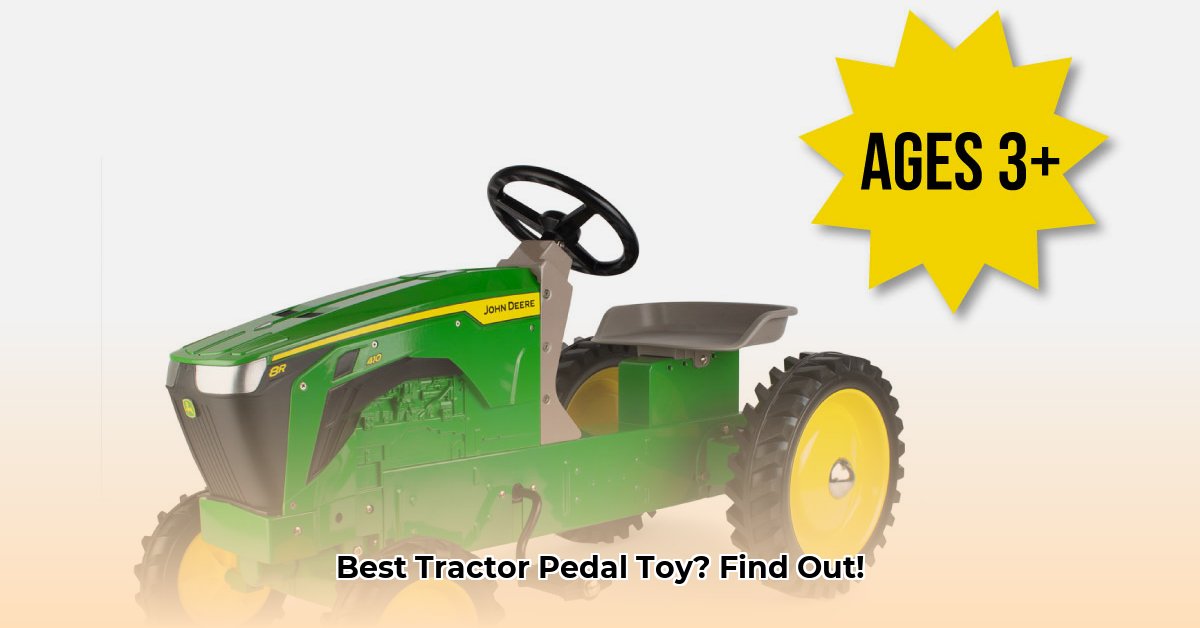
Remember the pure joy on a child's face as they conquer the backyard on their very own pedal tractor? This simple pleasure, this feeling of freedom and accomplishment, is at the heart of why these iconic toys remain so beloved. But navigating the world of pedal tractors can feel like plowing a tough field. This comprehensive guide will help you find the perfect tractor for your family, ensuring years of happy playtime. For even more information on specific models, check out this helpful resource.
Understanding the Pedal Tractor Market: A Cultivated Niche
The pedal tractor market is a unique landscape. Most high-quality models are made in the USA, which brings the benefit of superior craftsmanship and durability. However, this also means higher prices and potentially significant shipping costs, especially for bulkier, more robust designs. Detailed market data is surprisingly scarce, making informed decisions even more critical. This does, however, mean fewer diluted options, allowing you to focus on quality rather than quantity. What this ultimately translates to is a focus on a curated selection of premium products built to withstand years of enthusiastic play.
(Illustration image: A diverse collection of pedal tractors – die-cast, plastic, and steel – showcasing different styles and features.)
Pedal Tractor Types: A Field Guide to Materials and Features
The core material choices significantly impact a pedal tractor's price, durability, and even environmental footprint. Let's break down the options:
Die-cast Metal: These are the heavyweights, built to endure years of rugged play. Their superior durability comes at a premium price point, reflecting both the materials and manufacturing process. While incredibly strong, their weight might present a challenge for younger children.
Plastic: Plastic tractors offer a lighter, more affordable entry point, ideal for younger children who might struggle with heavier models. However, their durability is generally lower, making them susceptible to dents, scratches, and breakage. Consider this the "entry-level" model with a lower financial commitment.
Steel: Steel tractors strike a balance, offering a mix of durability and affordability. They typically fall between the robust die-cast metal and the more fragile plastic options, offering a good compromise for many families.
(Table: A comparison table detailing the pros, cons, price ranges, ideal age ranges, and weight for each pedal tractor type.)
(High-quality images of various pedal tractor types to illustrate the differences in material and design.)
Choosing Your Perfect Pedal Tractor: A Buyer's Guide
Now for the fun part—choosing the ideal tractor for your little farmer! Here's a step-by-step guide:
Prioritize Safety: Look for smooth edges, sturdy construction, and a stable design. Always check for any potential hazards, like small parts that could pose a choking risk.
Set a Realistic Budget: Prices vary dramatically based on materials and features. Research options before deciding to ensure you are making an informed choice within your budget.
Consider US-Made vs. Imported: American-made tractors often boast higher quality and durability, but this translates to higher prices. Imported models can be more affordable, but it is vital to thoroughly check reviews for quality and safety assurances.
Think Sustainability: Inquire about a manufacturer's environmental practices. While full transparency isn't always available, looking for brands that highlight eco-friendly materials and reduced waste in their manufacturing process shows a commitment to sustainability.
Where to Buy: Online retailers offer a wide selection, but visiting local toy stores or farm supply retailers can help you get a hands-on feel for the quality and support local business. Always read reviews, regardless of where you buy the tractor, to get an unbiased perspective.
Maintaining Your Pedal Tractor: A Long and Happy Harvest
Regular maintenance will extend the life of your child's tractor, justifying the investment. Here's a helpful maintenance checklist:
Regular Inspections: Examine the tractor frequently for loose bolts, worn parts, or any signs of damage. Tighten any loose screws or nuts.
Cleaning and Lubrication: Regularly clean the tractor to prevent dirt buildup and rust. Lubricate moving parts (like the steering wheel) to maintain smooth operation.
Proper Storage: When not in use, store the tractor indoors or under cover. Protecting it from the elements will increase its lifespan.
The Enduring Appeal of Pedal Tractors: More Than Just a Toy
Choosing a pedal tractor is an investment in more than just a toy; it's an investment in lasting memories. These tractors foster outdoor play, ignite imaginations, and often become beloved family heirlooms. Remember to make an informed decision based on factors like durability, safety, and your child's age and interests, and enjoy the ride!